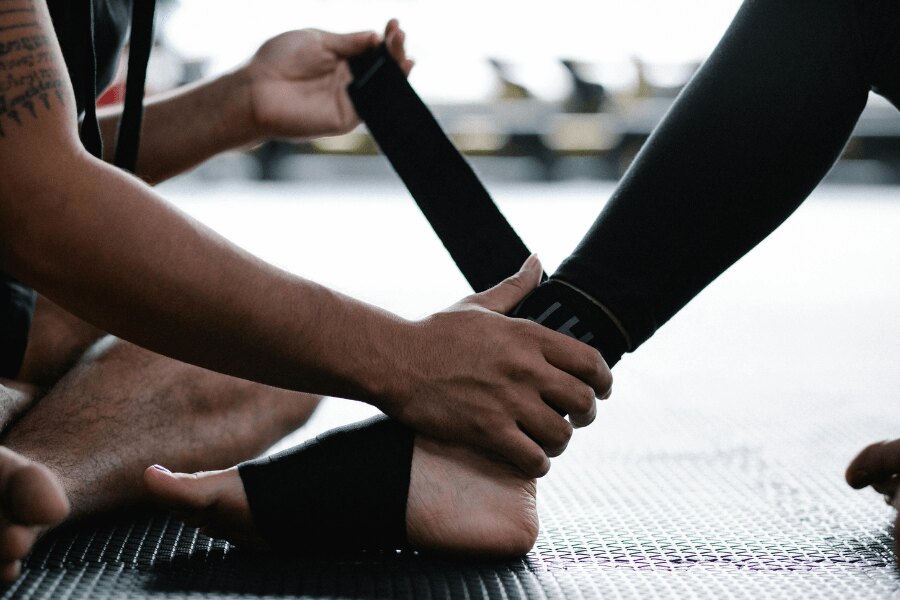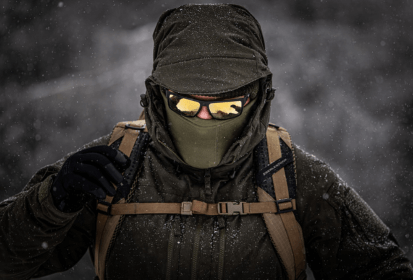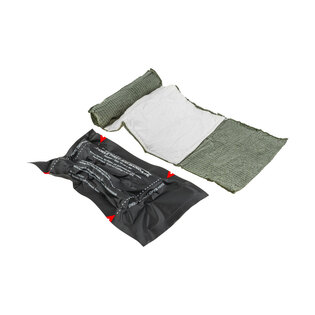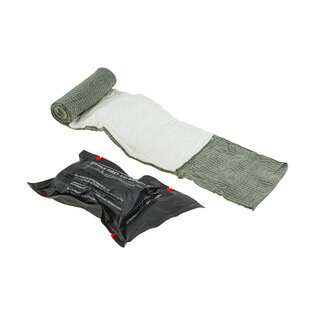Limb Injuries (Part 1): Stable Injuries
It only takes a single misstep for an injury to occur. In the best-case scenario, it's a stable injury—like a sprained ankle. In worse cases, it could be a fracture. But how should you react in these situations? And how can the acronym RICE help during first aid?
We’ll break all of this down in a series of articles designed to prepare you for anything your next adventure might throw at you. Today, let’s start with the “better” scenario: a stable limb injury.
Common limb injuries include sprains, contusions, strained or torn ligaments, dislocations, and various types of fractures. Sometimes, it’s obvious what kind of injury has occurred; other times, it can be difficult to tell. So how do you decide what you’re dealing with in order to take the right action?

Stable upper limb injury: wrist bandaging in case of suspected contusion or sprain.
Don’t Diagnose—Assess
The golden rule? Don’t try to diagnose the injury yourself. Leave that to the professionals. A specific diagnosis isn’t necessary for providing proper first aid—you just need to assess how serious the situation is.
Why? Because in the moment, especially in a remote or outdoor setting, you’re likely under stress. Conditions may not be ideal. You might not be able to see the injury clearly under clothing. And if you latch onto an incorrect self-diagnosis, your first aid response could become less effective. Realistically, how many of us have the experience to reliably recognize specific injuries in the field?
What you can and should do is assess the severity of the injury—whether it's low-risk or high-risk—and act accordingly.
How to Assess the Severity of the Injury
🧐 How to Assess Injury Severity
- Limb shape: Is the limb at a natural angle? Any visible deformities?
- Mobility: Can the injured person move it? Is the movement painful?
- Finger/toe sensation: Can they feel their fingers or toes? Any numbness or tingling?
- Circulation: Are the fingers or toes warm and evenly colored?
Stable Injuries: How to Recognize Them and What to Do
Let’s simplify things and categorize limb injuries as either stable or unstable.
A stable limb injury typically presents with:
- Preserved mobility
- The ability to bear weight (even if with discomfort)
- Mild swelling
For example, with a mild ankle sprain, the ligaments remain intact. The injured person may limp but can still walk.
In stable injuries, blood circulation and nerve function (sensation) are unaffected. The injured person can move their fingers or toes, and their range of motion remains largely intact—though some swelling may occur. These injuries do notrequire immediate transport and can often be managed temporarily on-site.
🆘 First Aid for Arm or Leg Injuries: Think RICE
🆘 First Aid for Arm or Leg Injuries: RICE
- R – Rest: Limit movement and avoid putting weight on the injured limb.
- I – Ice: Apply a cold pack wrapped in cloth for up to 20 minutes. Do not apply ice directly to the skin.
- C – Compression: Use an elastic bandage to help control swelling.
- E – Elevation: Raise the injured limb above heart level to reduce swelling.
👉 Seek medical attention if the condition worsens. Otherwise, use your judgment. You may administer anti-inflammatory or pain-relieving medication and apply ointments if needed.

Stable lower limb injury: ankle support using an elastic bandage.
Unstable Limb Injuries: Warning Signs
With an unstable injury, the limb cannot bear weight. Key warning signs include visible deformity or impaired sensation. In such cases, immediate medical transport is essential—call emergency services.
👉 The standard emergency number in many countries is 112, but be sure to check the current emergency number specific to your location or the country you’re in.
👉 If you're in a remote area and emergency help isn’t available, you’ll need to immobilize the limb and consider improvised transport if absolutely necessary. We’ll cover this in detail in the next article on unstable injuries.
Summary: Key Takeaways for Stable Limb Injuries
A stable limb injury means the limb can bear weight, retains its natural shape and mobility, and circulation and sensation are not impaired. Still, it’s essential to stay calm, assess the condition, and act appropriately.
✔ Assess severity based on shape, movement, circulation, and sensation.
✔ If these are preserved, you’re likely dealing with a stable injury.
✔ Follow the RICE method: rest, compression, elevation, and cooling.
✔ Monitor the situation—seek medical care if it gets worse.
✔ Unstable injuries require a different approach—we’ll cover that next.
❖ SERIES: FIRST AID FOR LIMB INJURIES
Read the full series and gain confidence in how to respond to injuries in the field.
- ➤ Part 1: Stable Limb Injuries
You’re currently reading this article. - ➤ Part 2: Unstable Limb Injuries
- ➤ Part 3: Immobilizing an Injured Limb
- ➤ Part 4: Improvised Transport & Recommended Gear
(coming soon)
Note: This article was created in collaboration with Dita Voltr Podhadska, a certified first aid instructor with ZDrSEM and lead instructor of the HORAL outdoor first aid course.
Readers are further interested















































































































































